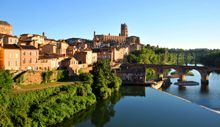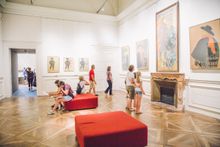 12 Mar 2019
12 Mar 2019
Tags: France, Art, Holiday, Southwest France, Spring, springbreak, Shorthaul, Europe, Culture

Albi in Occitanie, southwest France, is the birthplace of French painter Henri de Toulouse Lautrec, famous for his works depicting Belle Epoque Paris and his Moulin Rouge posters. With comfortable temperatures of around 18 degrees in April, Albi, makes the perfect getaway for art-lovers looking to experience the French joie de vivre and enjoy a Spring break.
The museum dedicated to his lifework is about to host a new exhibition on Swiss-born sculptor Alberto Giacometti, giving an extra reason to trace Toulouse Lautrec's footsteps and uncover this preserved region of France.
A weekend stay in Albi starts from £391 for two people, including flights and accommodation for two nights with breakfast included. This is based on a visit from 19-21 April 2019, staying in the centre of Albi at 4* Hotel Mercure Albi Bastides, a former working mill from the 10th century located on the banks of the river Tarn. The flights are with Ryanair from London Stansted. To book visit www.lavermicellerie-hotelmercure.fr and www.ryanair.com
Your Recommended Route
When starting your journey in the footsteps of Toulouse Lautrec, head first to the Toulouse-Lautrec Museum (www.musee-toulouse-lautrec.com), located at the very centre of the town in the square Place Sainte Cecile. Take a moment to take in the imposing nearby Sainte Cecile Cathedral, the largest brick-built building in the world. Added to the UNESCO's list of world heritage sites in 2010, it is perhaps the best example of Albi's distinctive red-building style and architecture.
The Toulouse-Lautrec museum itself is located just yards away from the cathedral in the nearby Berbie Palace. Established in 1922, it showcases the lifework of the artist, who despite having suffered an early death at the age of 37 had an exceptionally productive career. Over 219 paintings and 563 drawings are presented, from his very first sketches at the age of 12 to the lithographs depicting the lively nightlife of Belle Epoque Paris that made his name. Not to be missed are his promotional posters of Parisian dance-halls and cabarets such as Moulin Rouge, whose Japanese inspiration revolutionised modern advertising and influence art even to this day.
From 15 March to 30 June 2019, the museum will also be housing a temporary exhibition on the work of Swiss-born sculptor Alberto Giacometti. Presenting over 80 artworks, the exhibition will tell the tale of an artist's endless quest for the perfect depiction of the human body. Sketches and drawings of the many illustrious figures Giacometti met during his life in Paris will also be on display, offering a touching tribute to famous names such as Simone de Beauvoir or Jean-Paul Sartre.
As you step out of the museum, turn right and follow the narrow alley that leads down to the stunning Berbie Gardens. There you can admire the French-style gardens by walking under the flower canopy, allowing you to soak in the beautiful views on the River Tarn below and the medieval citadel behind. The Pont-Vieux -the oldest bridge in Albi- and the numerous red-brick buildings across the river all create a timeless landscape similar to the ones which inspired Lautrec's early works.
As you return to the medieval streets, spot the many Tudor style houses, narrow alleys, secret passageways and guildhalls which have barely changed in centuries. Toulouse Lautrec's presence is still very much felt through the streets of Albi, and you might see many quotes displayed on shop windows across the town in a similar handwriting – they are famous quotes from the painter himself, fondly displayed by the Albigeois.
To end your journey through Albi, walk up Rue Henri-de-Toulouse-Lautrec and pause in front of Hotel du Bosc, easily recognisable thanks to its grand gate and impressive 18th century façade. It was there that Toulouse Lautrec was born in 1864 to an aristocratic family, and where he suffered the ill-fated accident that left him reliant on a walking stick for the rest of his life -stunting his growth and giving him his well-known, child-like stature.
Today the hotel is privately owned, but you can still see some of its 18th century architecture by walking across the paved street to the former stables, which have been converted to restaurant Le Lautrec (www.restaurant-le-lautrec.com). The restaurant retains almost all of its original features -including a 18th century well- and provides the perfect setting to discover the rich gastronomy of the Tarn. If the weather allows it, have a seat under the canopy of wisteria on the front patio and treat your taste buds with homemade dishes similar to the ones Lautrec himself would have enjoyed in his youth, such as Fois Gras, duck, cassoulet, and of course, the Lautrec Pink Garlic.
Further afield
Outside of Albi, head to the village of Lautrec at the heart of the 'Pays de Cocagne' to discover the ancestral home of the painter's family. The historic village is full of charming medieval houses which retains much of their original features and boasts several restored workshops in which you can learn more about the traditional crafts of the area.
The family also owned Chateau de Mauriac, which was built by one of Toulouse Lautrec's ancestor -a templar- in the 13th century. Today the castle retains much of its cultural heritage and artistic ties: it was bought in the 1960s by painter Bernard Bistes, who created large galleries in the various rooms to display his beautiful artwork.
-Ends-
For more information please visit Le Tarn Tourisme, www.tourisme-tarn.com/tarn/en
High res imagery is available here.
Media information:
Margaux Movet
+44(0)20 8614 7507



